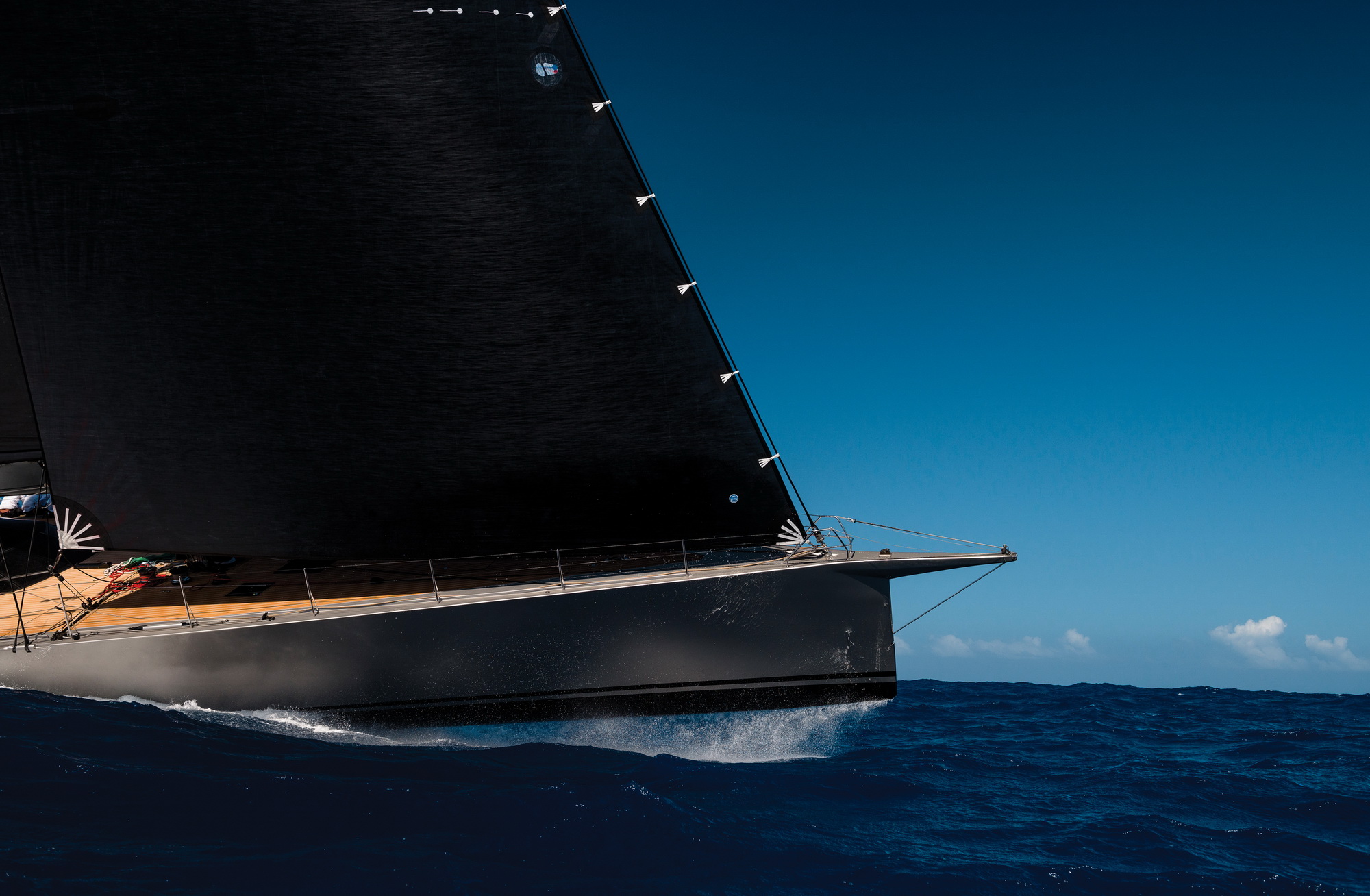
10 MIN READ
Converting a famous race boat to a performance cruiser while preserving and honoring her history was a project that required an owner with a singular vision.
Article by Boat International and Showboats (words: Marilyn Mower - main photography with article: Jeff Brown/Breed Media) complemented with photos and information from a previous inhuis publication.
“Commence lowering tables,” came the order from the captain. “Lowering tables,” came the response from the deckhand, and the cockpit tables were folded and stowed. Trust me, this is not part of the starting sequence for typical racing yachts, especially ones that average speeds in excess of 20 knots. But then SAMURAI is far from typical, either in her original build or in her freshly refitted cruising incarnation.
As Mari-Cha IV, the 139-foot schooner’s sole purpose was to set speed and distance records over offshore courses with all sails handled manually (two teams of grinders and trimmers working 21 winches on deck). Delivered in 2003 to her former owner, Robert Miller, she accomplished her goal with such feats as breaking the transatlantic record right out of the box, making the crossing in six days, 17 hours, 52 minutes and setting a sailing record of 525 miles in one 24-hour period. She also won the Rolex Transatlantic Challenge, broke the Guadeloupe to Antigua record and the Hawaii Pacific Ocean record, where she sailed 2,070 miles in just over five days, smashing the old record by 32 hours.
But fame is fleeting; this former superstar was sold and eventually put out to sailing’s equivalent of pasture — a slovenly backwater berth. Mari-Cha IV was so purpose designed by Philippe Briand, Clay Oliver and Greg Elliott that there was just one Spartan cabin below for the owner. The crew, and there would be 25 aboard to race, slept hot-bunking on pipe cots wedged fore and aft of ballast tanks and huge boxes housing hydraulic rams that canted her keel up to 40 degrees either side. The shallow underbody, more like surfboard than sailing yacht, and the towering schooner rig made her an “e-ticket” ride capable of 40-plus knots. She was a rocket ship.
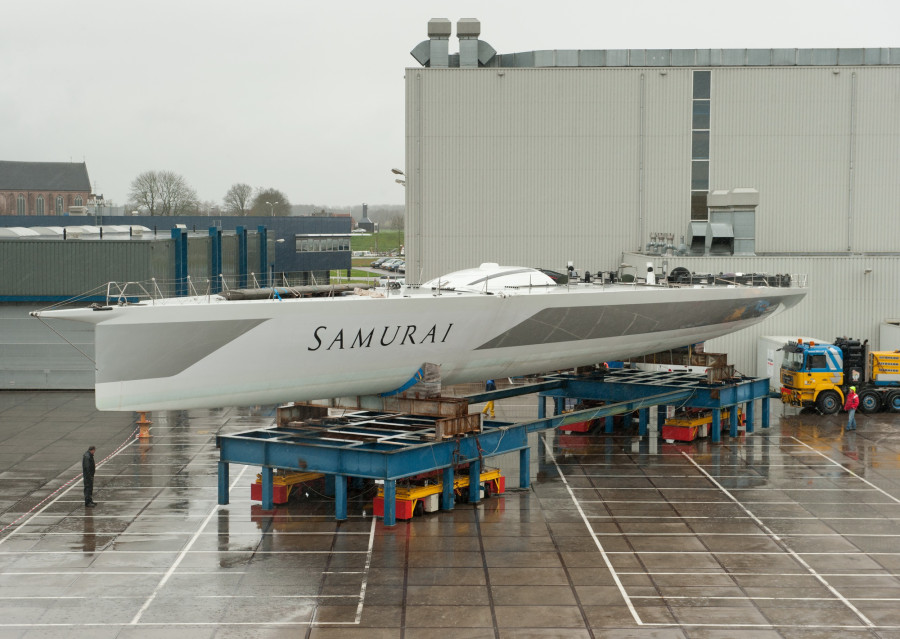
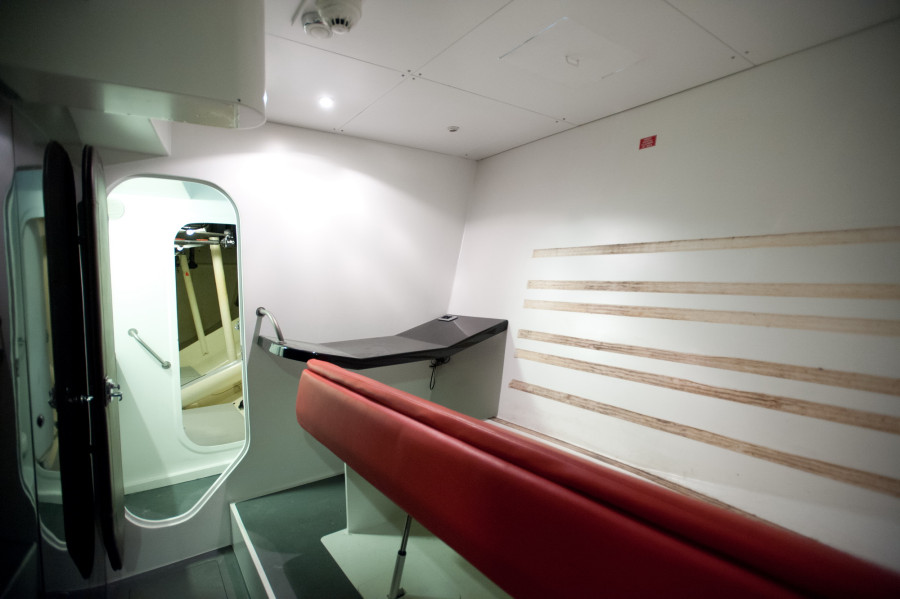
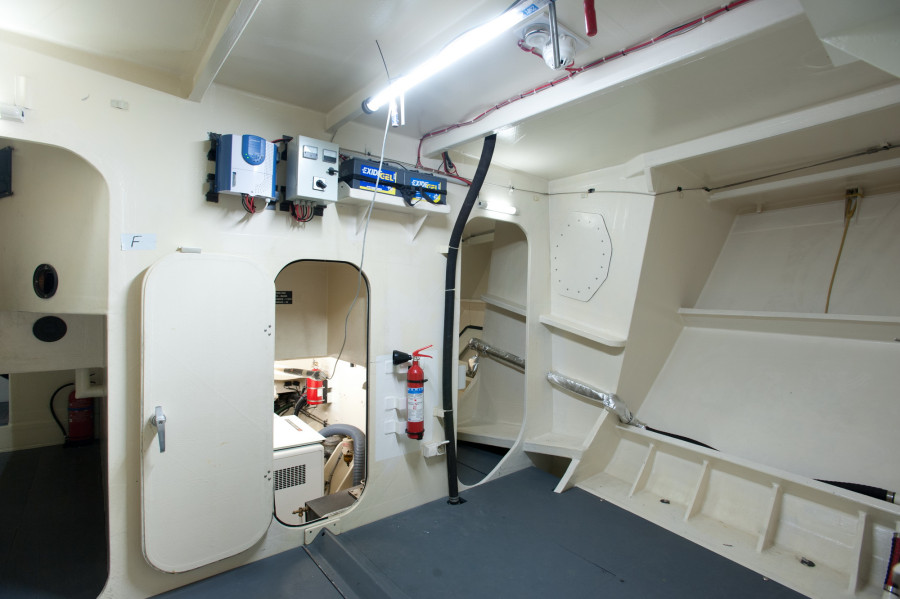
On Mari-Cha IV, there was
a suspended nav station
under a short canopy
and nothing but empty
sail storage below
and forward.
Times and ideas change. Now, those in search of speed records favor foiling multihulls or trimarans. Monohull fans favor smaller boats in the super Maxi class. Even though Mari-Cha IV was state-of-the-art in composite building in 2003, a comparable sloop today weighs about 20 tons less. When specialist sailing yacht broker Will Bishop of Yachting Partners International (YPI) began sounding out potential owners who might be interested in turning the boat into an exciting cruiser, racing purists cried “heresy.”
“Of course, none of them were stepping forward to rehab the boat,” he says. And then, from an unlikely corner — classic cars to be precise — came an interested party with a singular vision. The boat’s history needed to be preserved and honored, he said, and the best way to do that was to show how she could be a no-compromise cruising experience. He rejected sketches that showed the yacht’s rig and deck modified, including one with a deck salon. Respecting the original profile was paramount and that meant maintaining the twin towers of carbon fiber that carried 9,612 square feet of sail.
Out of sight would be desired modifications to power the winches, allowing the boat to be sailed with 10 crew, and a lifting keel to access more harbors. The big challenge would be fitting in a cruising interior, a galley, watermaker, sewage treatment and air conditioning without wrecking performance.
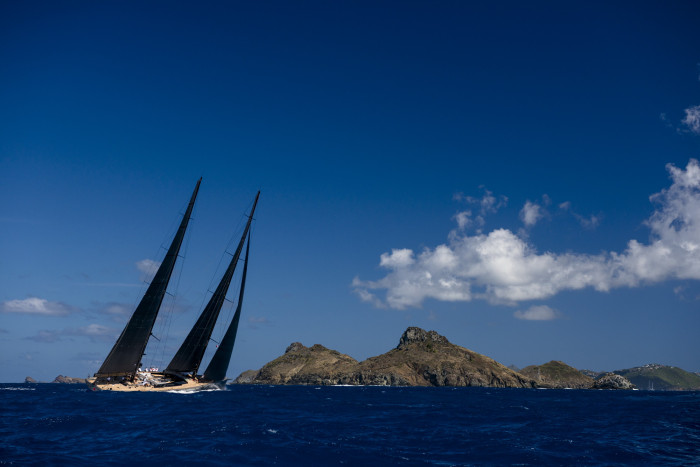
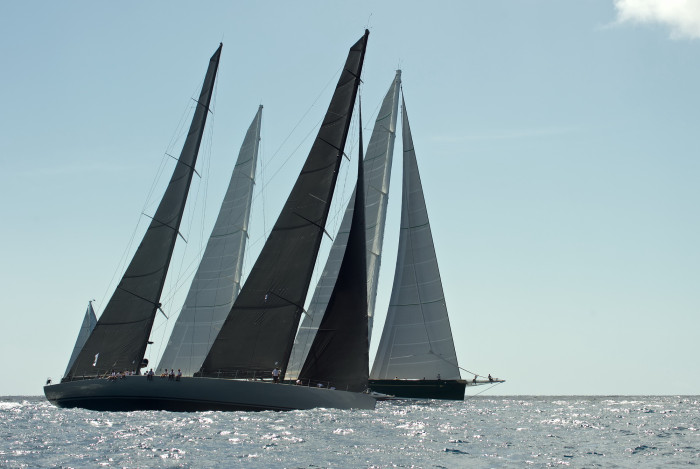
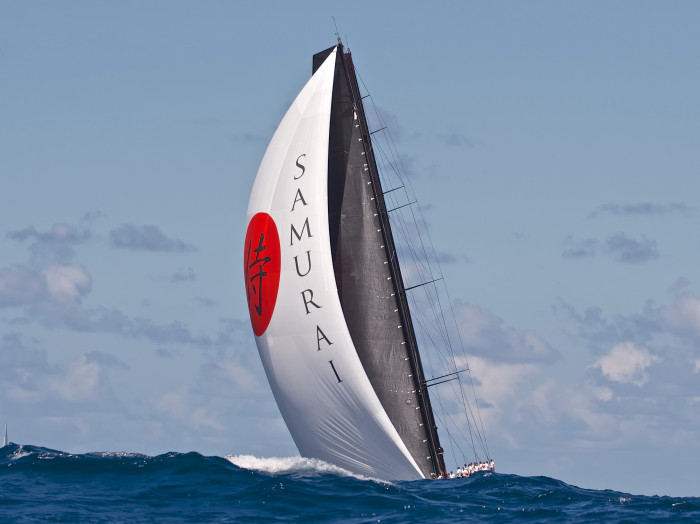
Black 3Di sails
from North Sails
add to SAMURAI’s
stealthy look,
which keeps the spirit
of the old race boat alive
The owner and Bishop began by tracking down Elliott to shepherd the numbers and hiring British firm Rhoades Young to take care of the styling and interior design. Jonathan Rhoades and Dick Young have probably designed more lightweight sailing yacht interiors than any other company. What the firm often doesn’t receive enough credit for is its contribution to exterior styling. With this project, adding mod cons without destroying the stealthy profile was key.
“Truth be told, SAMURAI is all about ‘the experience.’ No one else seemed to get it,” says Rhoades. “The owner wanted a new superyacht. What drew him to this project was the pedigree. He had tons of photos of Mari-Cha IV racing. He wanted a ‘blowing-(your)-socks-off experience.’ What he’s done is create a completely new animal.
Bishop agrees. “I’ve sold nine sailing yachts in two years. People want performance more than anything. Today, owners are designing boats for superyacht regatta racing. That used to be an afterthought. Mari-Cha IV was not only beautiful, but she accomplished her mission; the owner felt she just couldn’t be allowed to rot.”
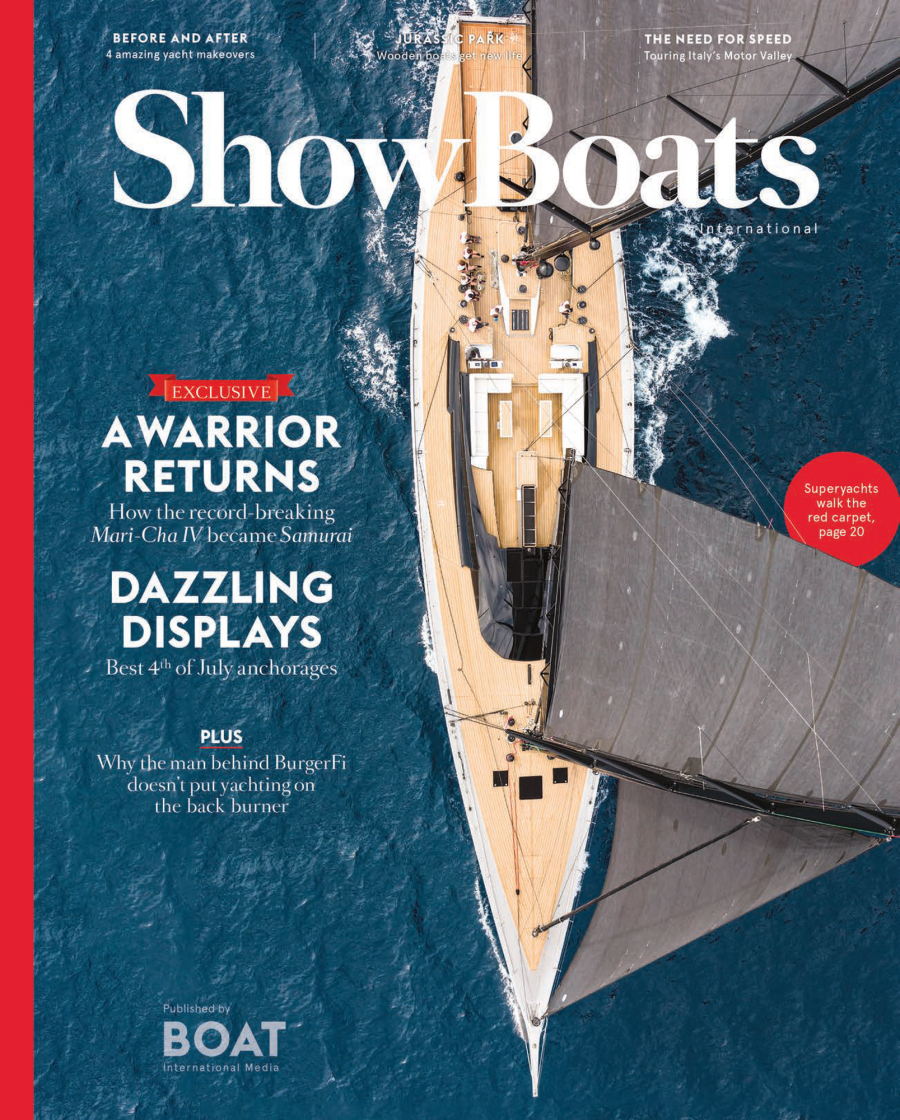
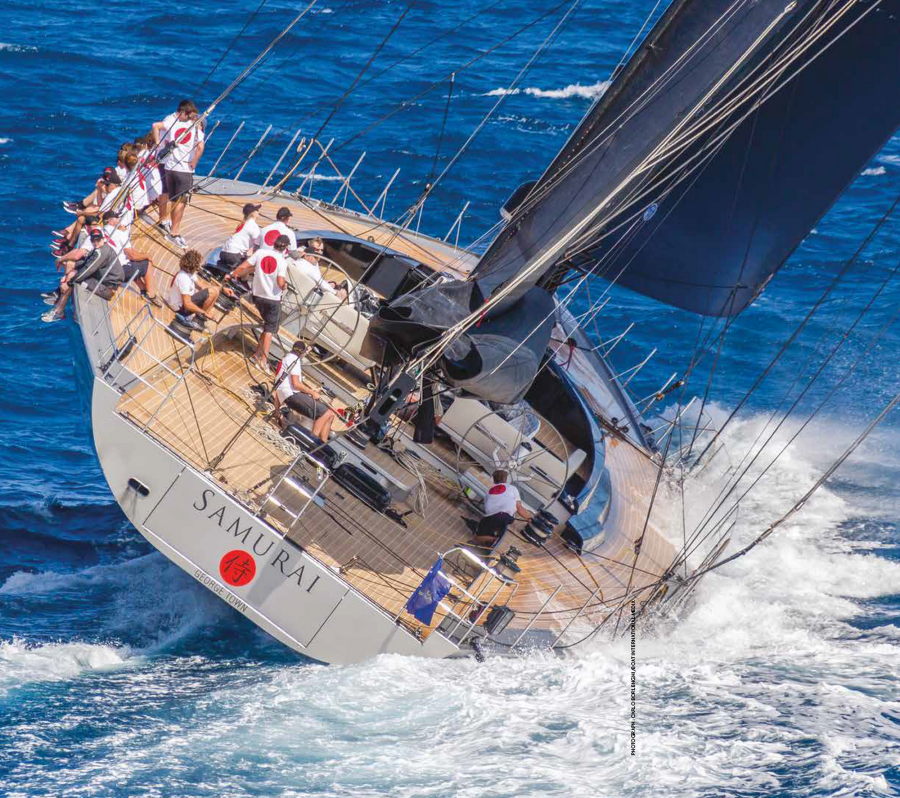
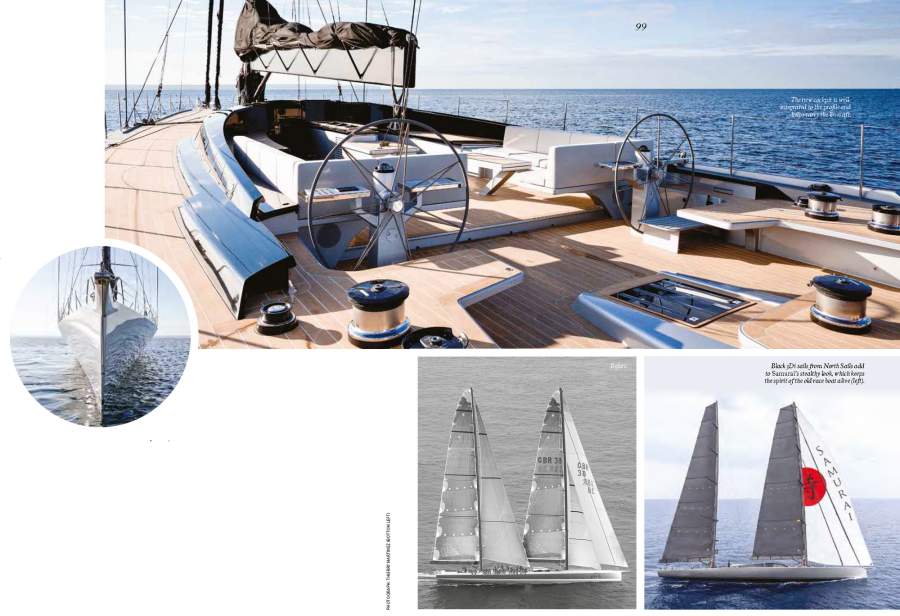
From stripped-out
speed machine
to high performance
luxury machine.
Max Riedl of Cornelsen & Partner, a project management firm with an impeccable history of refits and new builds, commented on the theme of the owner’s vision: “I was worried about making the boat a compromise between a racer and a cruiser and being very bad at each job. But he had a vision, he saw this as a modern Endeavour in that the original mission would be honored.”
In modifying the boat, the critical driver and unrelenting master was weight, says Greg Elliott. As the one who knew the most about her original engineering, he was brought on as the numbers man and designer of a new lifting keel. When the owner said he wanted to keep the yacht’s profile, he meant the entire profile, including the pair of 148-foot masts that gave Mari-Cha IV her unprecedented power.
“The weight budget was where we began. That rig,” he said pointing skyward, “is made for a certain load, a certain righting moment. Keeping the rig and changing the keel from a deep canting foil to a lifting vertical foil gave us an equation without much room for error or interpretation,” says Elliott.
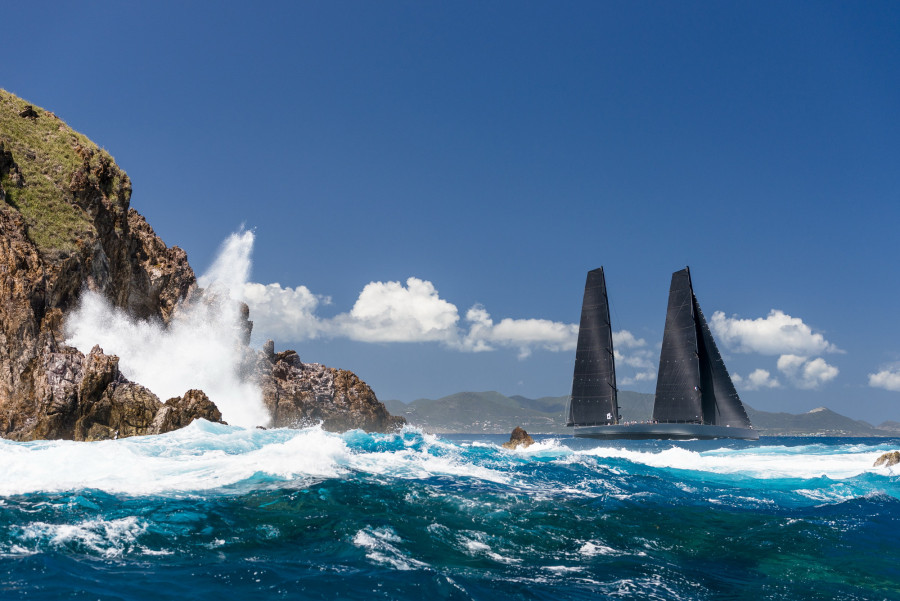
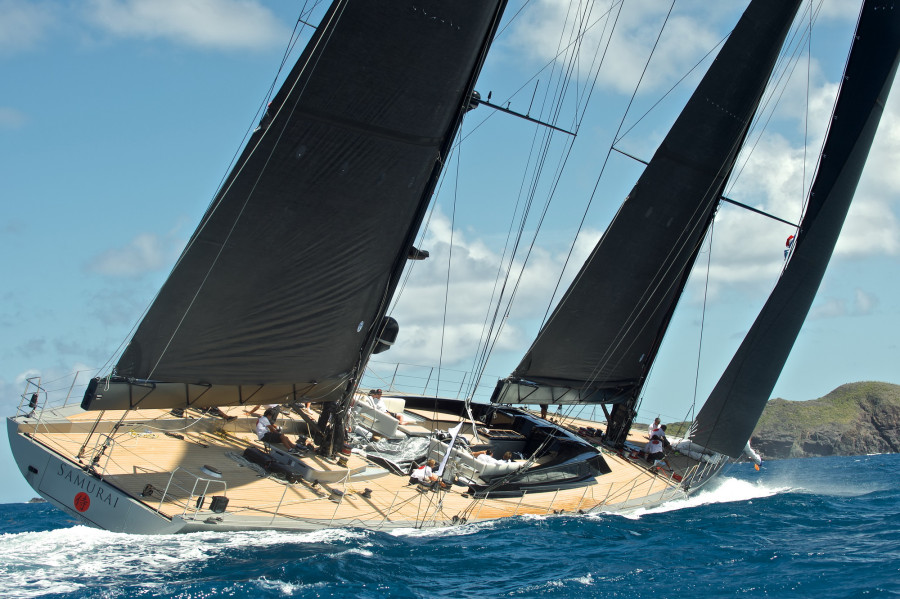
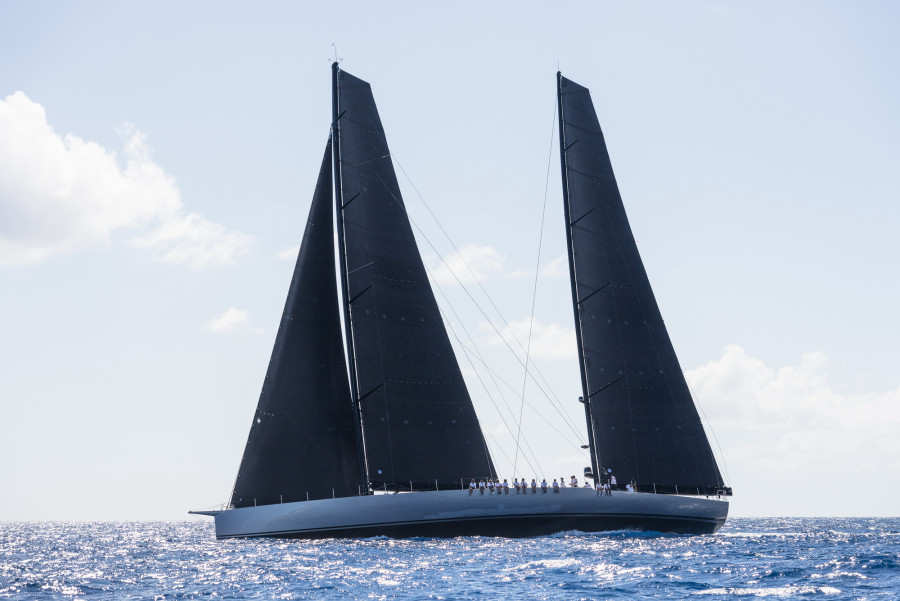
The new cockpit
is well integrated
to the profile and
helps carry
the lines aft.
The team refined the plan and made more interior room by removing the hydraulic rams that forced the original keel from side to side for stability. The mezzanine-level nav station was cast aside to provide an atrium entrance to a salon. Cockpit coaming was added to make a safe seating area for guests during sailing and to shelter al fresco dining when moored.
The modifications to the carbon structure were extensive due to the complexity of incorporating the new lifting keel and the interior, so leading composite specialist Gurit was brought in to rigorously scrutinize and design the whole process.
Once the plan was organized, the refit went to bid with several yards. While its price wasn’t the lowest, [Huisfit by] Royal Huisman was the owner’s choice, thanks to the yard’s reputation and brand pedigree.
Huisfit by Royal Huisman for a carbon fiber racing yacht refit? [Huisfit’s spokesman] laughs at the question. “We’ve been doing a lot of bits and pieces in carbon fiber and our sister company, Rondal, is a carbon fiber expert and not just masts. We make parts for other Dutch yards, such as doors and hatches and arches.”
On deck, it’s easier to point out what isn’t original to Mari-Cha IV than what is: the cockpit tables and huge C-shaped sofas. The wheels, the masts and booms all saw the original action, as did all the winches and the steering gear. The aft pod of winches has been relocated farther aft but they (and those at the base of the main mast) are the historic lot, although they are motorized now. The yacht’s “stealth fighter” look is highlighted by her new suit of black 3Di North Sails, a perfect application of the company’s molded sail process utilizing carbon, Aramid and Dyneema fiber. Engineered to assume the perfect flying shape when hoisted, they appear to present a single, shiny, smooth surface to the air, not unlike a hard wing sail.
The winner of the
first Atlantic crossing
was Xanthe Bowater,
the youngest crewmember.
She topped the chart
by surfing SAMURAI
to 36 knots,
just five knots off
Mari-Cha IV’s best.
The transition from a carbon tube to a yacht with a master and four guest staterooms has naturally increased the displacement and her difference from light ship to fully loaded is a modest further eight tons. “Where you put the weight is just as important as the amount,” notes Elliott, and getting the “yacht look” without massive weight was a puzzle that involved everyone. “I gave them the bottom line of how much weight they could add to the boat and it was up to them to allocate it,” says Elliott.
Huisfit by Royal Huisman weighed the whole structure monthly as a check on the material weights coming on or off the boat. Flexiteek (1,875 pounds) set into the deck and cockpit provides the non-skid finish. Entertainment electronics account for two tons. Captain Alec Rhys, a veteran of Whitbread Round the World Races, came up with a way to save 550 pounds in the galley by creating a half-pipe and roller system for managing the cooktop and oven instead of using a standard gimbaled stove. Likewise, the crew created a clever anchor management system that weighs next to nothing (110 vs. 1,320 pounds for a powered anchor deployment system) and dissembles completely for racing. The carbon hull is skimfilled and painted with a custom silver paint rather than fully faired. It saves weight, but more importantly, the owner didn’t want to hide that the “boat had had a past.”
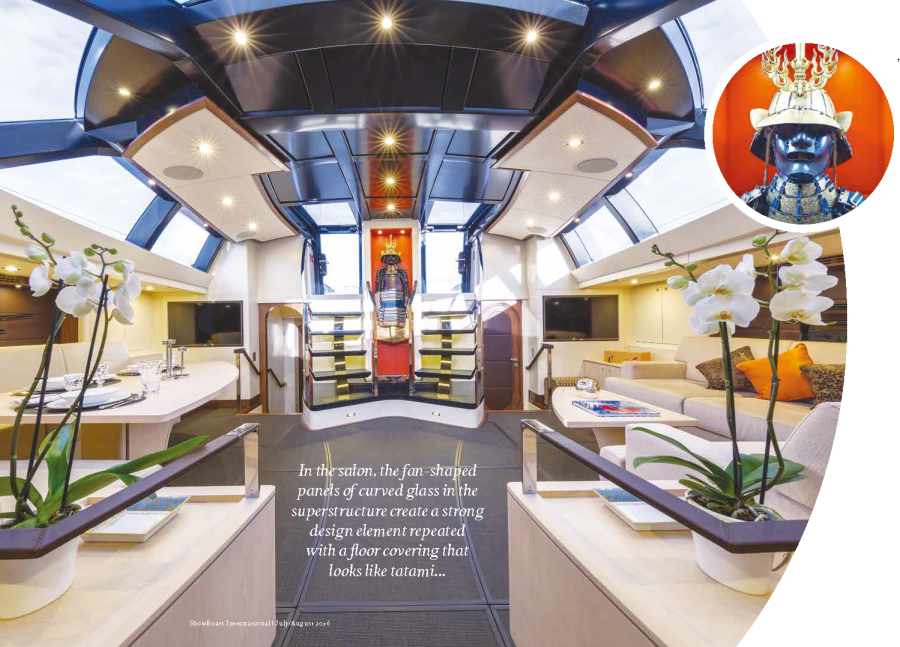
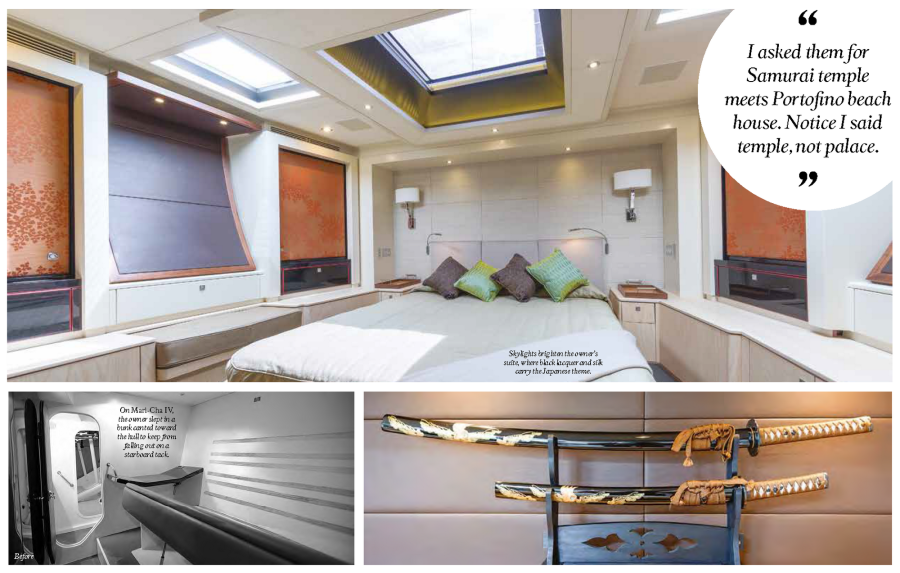
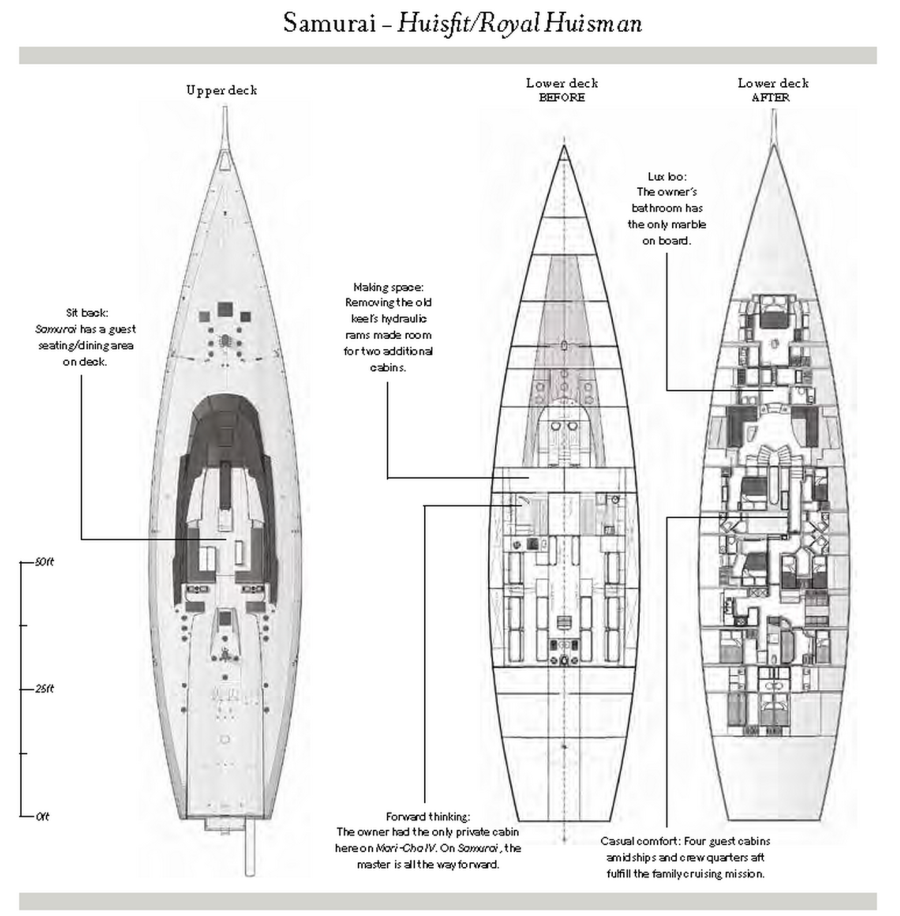
An Edo-period
SAMURAI artifact
stands watch over
the new salon.
While SAMURAI will do some racing, her mission is primarily family cruising and the owner’s brief to the designers was as unusual as the concept itself.
“I asked them for Samurai temple meets Portofino beach house,” the owner explains as we punched upwind on a 30-mile race course without so much as a drop of spray spoiling the conversation. “Notice I said Samurai temple, not palace.” The interior is calm and uncluttered and much larger than you might expect, but it is far from stripped-out racing machine. Within the weight budget, there is room for both coziness and flair with silk wall panels and an ancient Japanese warrior’s armor and a 16th-century Edo period sword.
“If a man does not have history, he does not have a future,” says the owner. “We adore history. Look at the place that Japan held in the world during that time. They were the fiercest feudal culture and yet, at the same time, supremely disciplined and creative. The history of the SAMURAI is clear — he had to be the best at every moment and live by an unbreakable code of honor.”
Rhoades Young and [Huisfit by] Royal Huisman collaborated on the yacht’s new GA, a largely symmetrical layout that Rhoades says is really the only one possible. “On a boat you have so many levels and shapes and intrusions…symmetry and order make people comfortable and feel at home.”
In the salon, the fan-shaped panels of 2D curved glass in the superstructure create a strong design element repeated with a floor covering that looks like tatami but in a synthetic fiber that is softer under foot and beautifully bound in waterproof leather borders. Port and starboard L-shaped sofas serve for lounging or dining with multi-functional tables made by Greenline Yacht Interiors. With virtually no tween-deck space to work with, the designers had to be very clever with their lighting plan. “We obviously had no space for can lights in the overhead,” says Rhoades. “We relied on ambient lighting spilling out of reveals and secret places and used dark corners to create shadow and thus blur the edges of rooms to make them seem larger.”
I asked them for
Samurai temple
meets Portofino
beach house.
Notice I said temple,
not palace.
Rhoades Young undertook its own weight studies to create a balance between spaces requiring durability and sound dampening and those where more delicate materials could be used. Lighting choices and how the electrical supply was distributed were factors. “What do the black boxes weigh and how many cables must you run? If you choose the right equipment and smart cable runs, you will offset the weight of a piece of furniture. Everything was on a spreadsheet, including the screws and glue,” Rhoades says. Of course, this is a superyacht with Baccarat crystal, Jasper china, Christofle silver and the odd Philippe Starck candelabra. “We really went round and round about the china, then I asked them what they had allowed as luggage weight per person. They told me 80 kilos. I said we will tell everyone to pack light. If we reduce that to 60 kilos per person, there is room for my 200 kilograms of crockery.”
So, at the end of the process, was there a penalty to be paid for the ancient armor or the bone china? Apparently not. The boat, says Rhys, is “still a weapon to sail.” On the yacht’s delivery from the Med to the BVIs for her first regatta, the crew — all serious racing sailors — pushed SAMURAI hard to make their rendezvous with the owner. As sailors are inclined, they kept track of each helmsman’s top speed recorded during his and her watch. The winner of the first Atlantic crossing was Xanthe Bowater, the youngest crewmember, who also happens to be an Olympic class windsurfer. She topped the chart by surfing SAMURAI to 36 knots, just five knots off Mari-Cha IV’s best. “I knew what I wanted to achieve, and this great team found a way to work for the final objective,” says the owner as we returned to port. “The only thing they didn’t anticipate was the speed at which we sail.”
Specs of SAMURAI – Huisfit by Royal Huisman - LOA: 139' (42.4m) - LWL: 124' (37.8m) - Beam: 31' (9.5m) - Draft (loaded, keel up/down): 14' (4.3m)/ 21' (6.3m) - Power: 1 x 35-hp Yanmar 6LYA-STP-264 kW - Generators: 2 x 32kW Northern Lights M944T - Owner and guests: 10 - Crew: 10 - Construction: Composite - Refit naval architecture: Elliott Marine - Refit exterior stylist and interior design: Rhoades Young Design - Owner’s representative: Will Bishop/Yachting Partners International - Project management: Max Riedl/Cornelsen & Partner - Masts and booms: Southern Spars - Sails: North Sails 3Di - Total sail area: 9,612 square feet - Deck equipment: Harken, Rondal & Royal Huisman - Speed under power: 10 knots (max) - Fuel capacity: 707 U.S. gallons - Refit yard: Huisfit [by] Royal Huisman
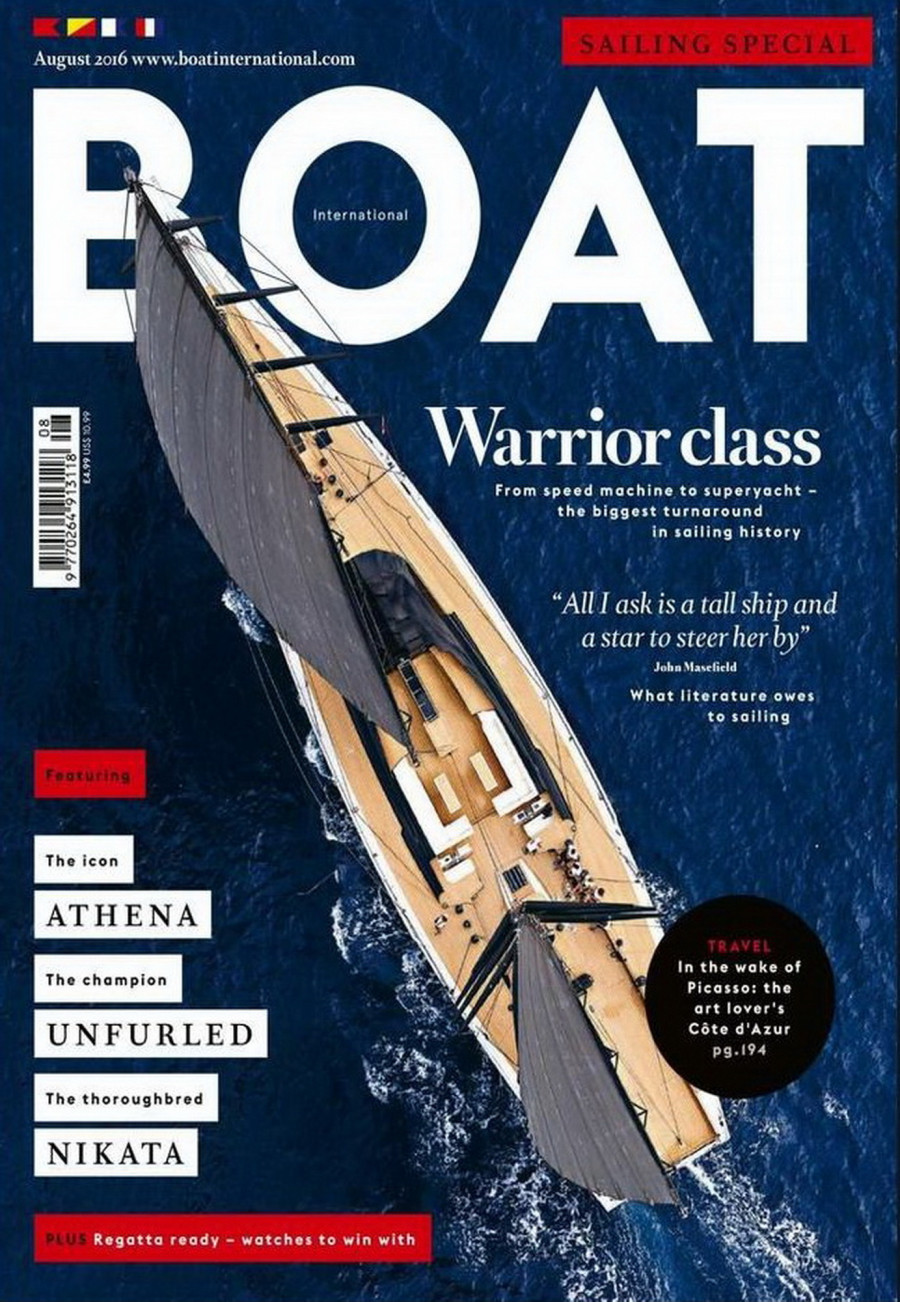
Another cover of
probably the biggest
carbon composite
conversion of its type
ever undertaken…
SAMURAI’S Huisfit conversion project at a glance
• Complete new carbon structure to include deckhouse, bulwarks, superstructure, coamings, cockpit (including realigned deck)
• Removal and rearrangement of structural bulkheads; reinforcements of in-situ structural elements
• Removal of dagger boards and trunking; localised reinforcement of their hull penetrations
• Remove and replace canting keel and mechanism with structurally integrated lifting keel and trunking
• New anchor system; rearrangement of winches (existing and new), skylights added above owner’s cabin, new deck surfacing, add bathing platform
• Install weight-saving interior
• Overhaul and upgrade existing systems (for propulsion, electricity generation, fuel system) install new board systems (for airconditioning, fresh water, sewage, bilge, highspeed hydraulic sail handling instead of manual, alarm and monitoring, fire extinguishing, navigation, communication, entertainment)
• Fair and paint hull as well as superstructure in new colour scheme
• Rig update including new continuous carbon standing rigging and new set of North 3-Di sails
